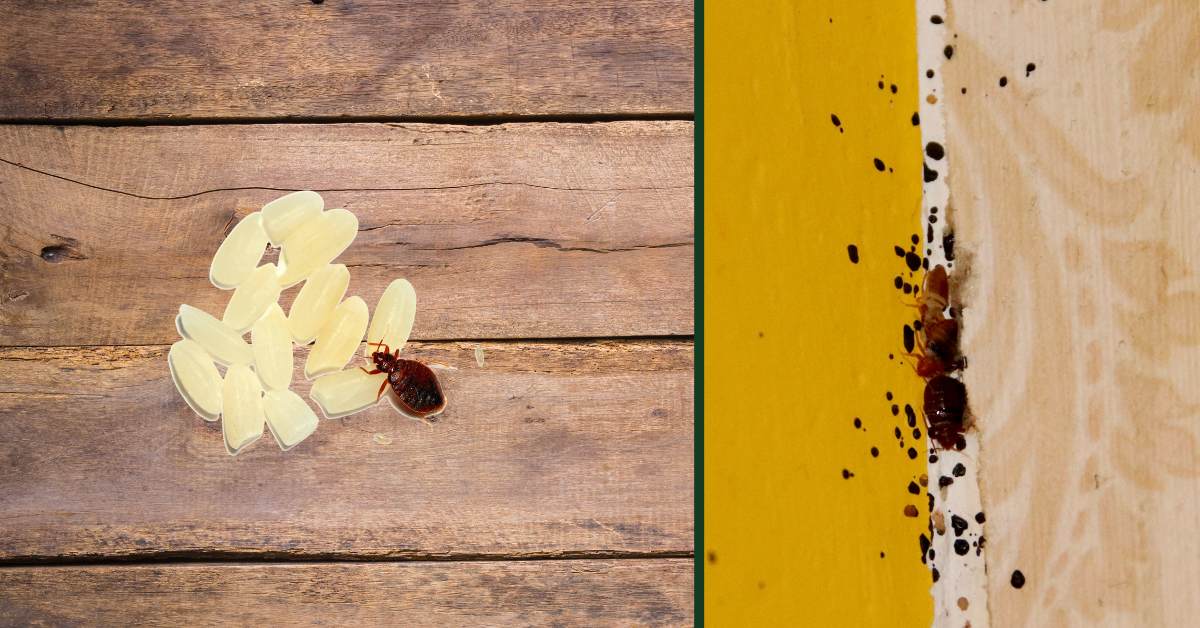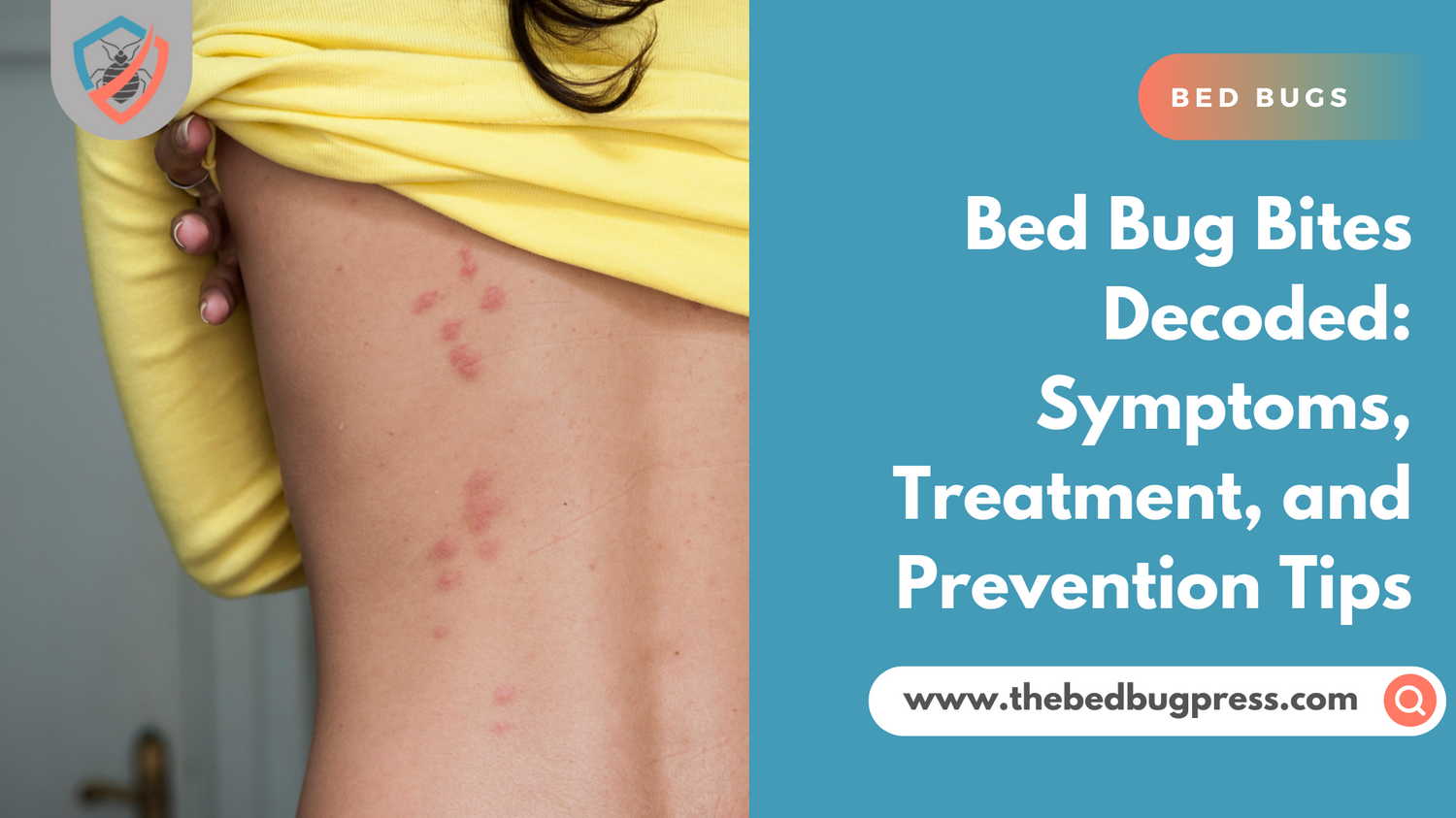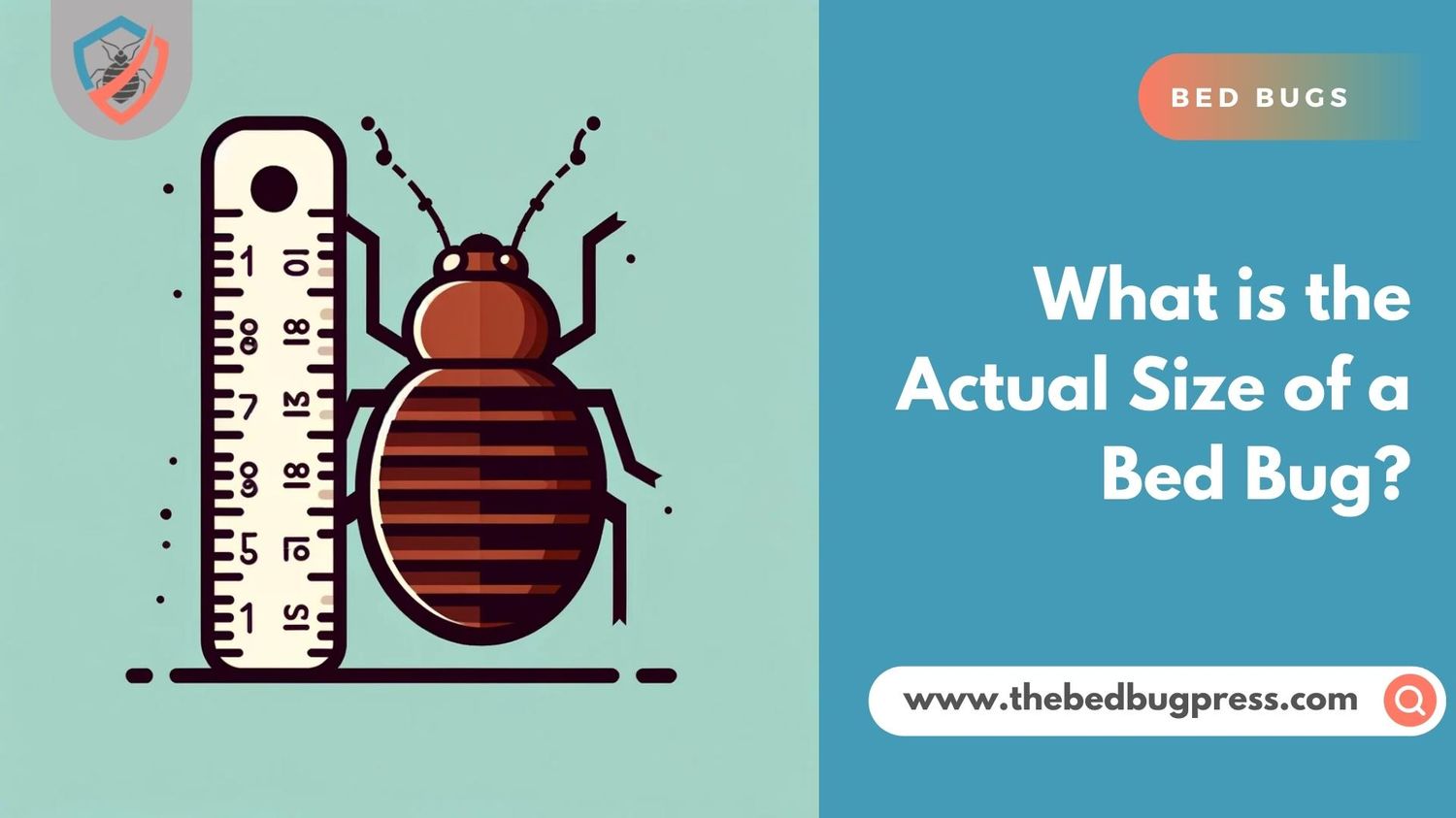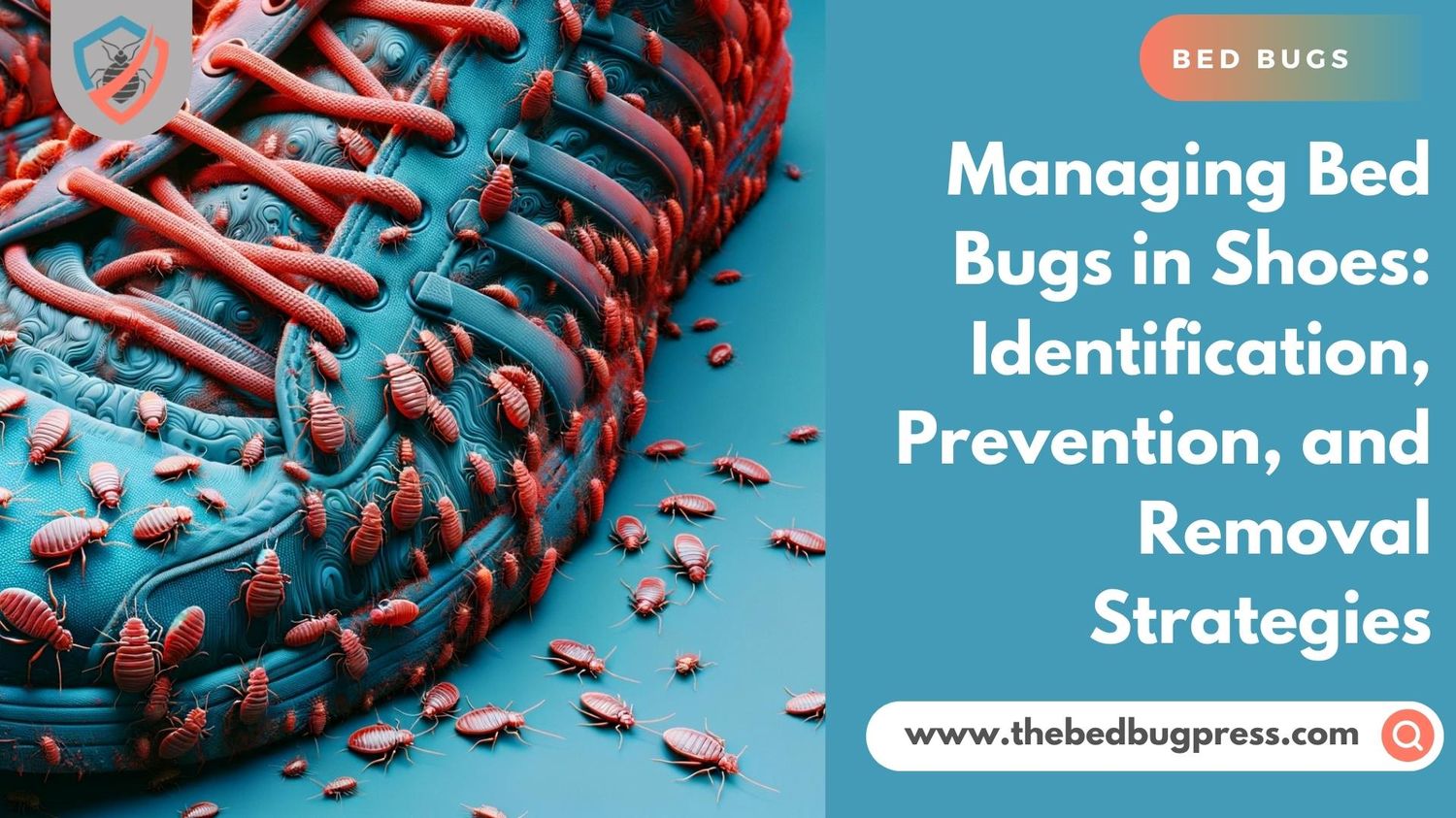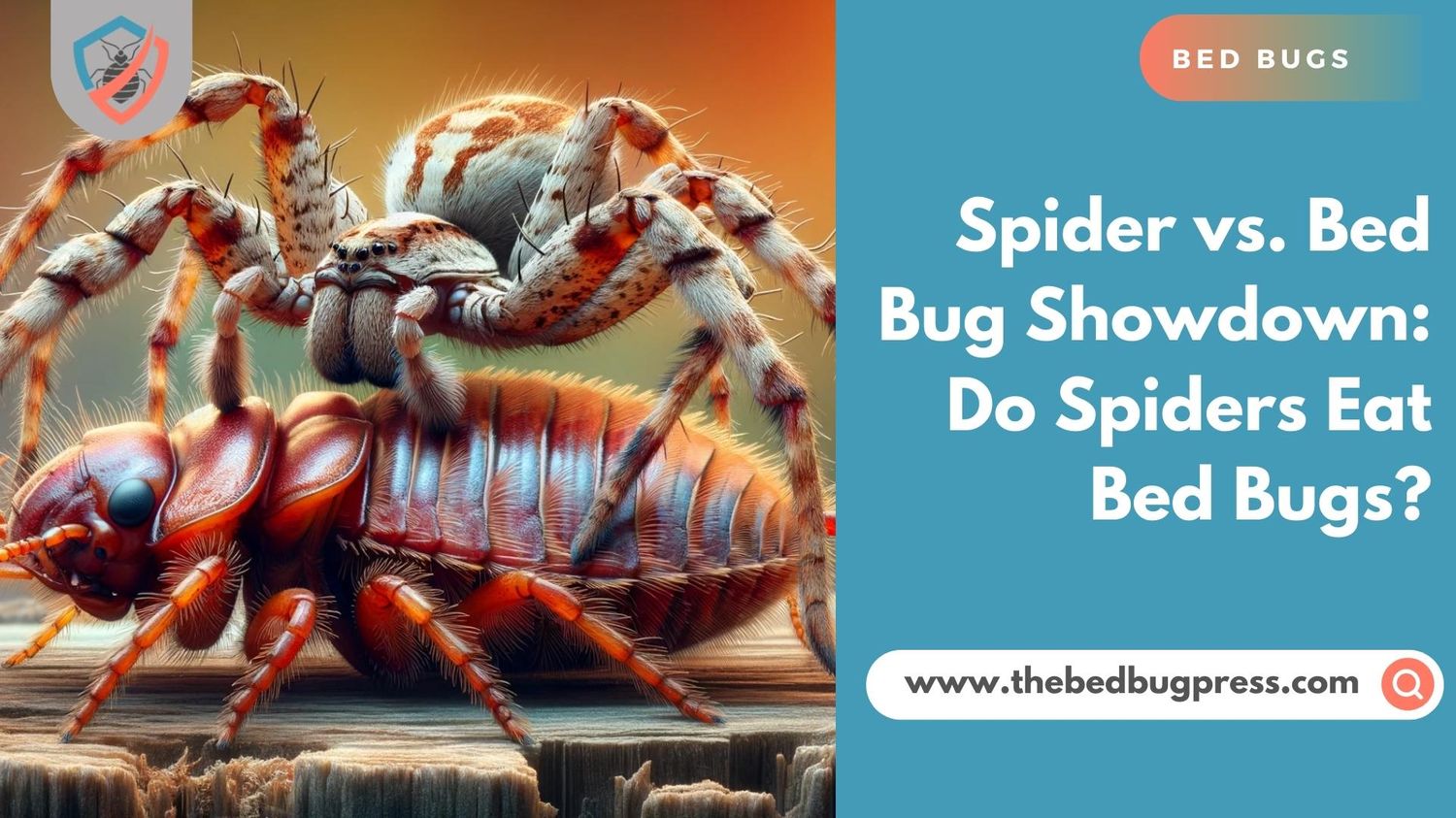Bed bugs can adapt to hostile environments and conditions. Both engineered and natural woods do not pose a huge problem for these critters.
Natural wood can easily get scratched, infested, worn out, or chipped by wood-boring critters. The cracks and crevices in the wood are the perfect spots for bed bugs to lay eggs and hide.

Bed Bugs Eggs and Signs on Wooden Furniture
The most common signs of a bed bug infestation include shed skins, dry bloodstains, live bed bugs, fecal brown marks, and a musky odor. It is difficult to detect their presence in tiny holes and cracks in wooden furniture and surfaces because they are flat and reddish-brown.
Upon close inspection of the cracks and crevices in furniture pieces or space behind baseboards, you may see eggshells or white eggs, adult bed bugs, small nymphs, and remnants of their exoskeletons from molting. This means that they do not only infest beds.

Can Bed Bugs Lay Eggs on Wood Furniture?
Yes, bed bugs can lay eggs on wood. They are not picky about where they deposit their eggs and will lay them in any crack or crevice they can find, including on wood furniture.
The eggs are small, about the size of a pinhead, and are usually laid in clusters. They are usually white or light-colored and can be difficult to spot.
Take note that bed bugs are most likely to lay eggs in areas where they are hiding, such as in the crevices of a wooden bed frame, the cracks of a wooden dresser, or behind baseboards. They may also lay eggs in other areas such as in electrical outlets, seams of mattresses, and box springs.
Make sure to regularly inspect your wooden furniture for bed bug eggs, as well as other signs of bed bugs such as fecal stains, shed skins, and live bugs. If you suspect you have a bed bug infestation, it’s best to contact a professional pest control company for a proper inspection and treatment.
What Do Bed Bug Eggs Look Like on Wood?
To check for these critters, you need a flashlight, a light-colored sheet, and a flat tool such as a knife. Place the sheet next to or under the furniture and then run the knife across joints and crevices to disturb the bed bugs.
Inspect the holes and cracks with the flashlight. You can also seal entry points before prodding their hiding spot to prevent the bugs from escaping.
Bed bug eggs on wooden surfaces may look similar to small, white, or translucent specks that are stuck to the surface of the wood. They may be found in clusters or groups and may be difficult to see with the naked eye. They can be found in cracks or crevices in the wood structure, or in other hiding spots near a bed or other furniture.

Do Bed Bugs Eat Wood Furniture?
Bed bugs do not eat wood furniture. They are ectothermic insects and have to feed on blood from warm-blooded animals in order to survive. Bed bugs are known to feed on human blood, but they can also feed on other warm-blooded animals such as pets.
Bed bugs will typically hide in wood furniture, such as in the crevices of a wooden bed frame or the cracks of a wooden dresser, but they do not consume the wood itself. They may also hide in other places such as behind baseboards, in electrical outlets, and in the seams of mattresses and box springs.
Keep in mind that bed bugs can cause damage to wood furniture if they are present in large numbers. They may leave fecal stains, and shed skins and eggs on the wood, making it unsightly. However, this is not the direct result of bed bugs eating the wood.
What Can Be Mistaken as Bed Bug Eggs on Wooden Furniture
There are several things that can be mistaken as these pests’ eggs on wood furniture. Some of the most common include:
Dust or debris
Dust and debris can accumulate in the crevices of wood furniture, and if not cleaned regularly, it can take on the appearance of small white eggs.
Wood filler
If the furniture has been repaired with wood filler, the excess filler can be mistaken for bed bug eggs.
Paint spatters
Paint spatters or drips can also be mistaken for bed bug eggs, especially if the paint is white or light in color.
Mold or mildew
Small clusters of mold or mildew can also be mistaken for bed bug eggs, especially if they are white or light-colored.
Carpet beetle larvae
Carpet beetle larvae can also be confused with bed bug eggs. They are small, and white, and can often be found in areas where there are natural fibers such as wool or silk.
Remember that bed bug eggs are small, white, and about the size of a pinhead. They are usually found in clusters and can be found in areas where bed bugs are hiding, such as in crevices, seams, and along baseboards. If you are unsure, it’s best to consult with a pest control professional for proper identification.

Common Spots Where Bed Bugs Hide
Do bed bugs lay eggs on wood? Do bed bugs live in wood? Bed bugs prefer to breed and nest out of sight. They will not stay in long-uninhabited places that cannot give them a blood meal.
Where they hide in your house depends on how suitable a certain structure or piece of furniture is. Bed bugs tend to hide in upholstered furniture, wooden surfaces, and furniture and furnishings that are made from textiles. That is why you will not find them on a marble countertop or plastic garden chair.
It is a different story when it comes to wood dressers. Be it a new bespoke wood dresser or an antique piece, this kind of furnishing provides a lot of dark spots for bed bugs to hide and lay eggs. Bed bugs can live in wood bed frames aside from mattresses and box springs.
The closer a possible hiding spot is to the blood meal, the more likely they will stay there. The space in the wood bed frame is one of those places. The uneven spots, grooves, and cracks in wooden slats, headboards, outer frames, and box springs also offer everything bed bugs need to thrive.

Confirming a Bed Bug Infestation on Wood Furniture
Confirming a bed bug infestation on wood furniture can be done by performing a thorough visual inspection of the furniture, and paying special attention to cracks, crevices, and other hiding spots.
Look for the bed bugs themselves, as well as their eggs, feces, and shed skins. If you suspect an infestation but do not see any visible signs, you can also use a bed bug trap or sticky tape to capture any bugs that may be present.
Another way to confirm an infestation is to hire a professional exterminator to perform an inspection. He can use specialized equipment such as a flashlight and magnifying glass to detect bugs, eggs, and fecal matter. They can also use specialized bed bug sniffing dogs to detect the presence of bed bugs.
Can You Use Caulk to Get Rid of Bed Bugs?
When you find a bed bug colony, you can call a pest control company first. You can then seal all possible points of entry with caulk to prevent a new batch of bed bugs from sneaking in again.
Use a caulk gun to apply the caulk evenly on every crevice, hole, groove, or hole of the furniture. This way, you can prevent the lucky survivors from escaping. You can also protect the treated wood floor from bed bugs by sealing it with a topical sealant or quality varnish.
However, keep in mind that using caulk alone to get rid of bed bugs is not a reliable solution. While it can help prevent them from entering a certain area, it will not kill the existing bed bugs.
It’s also important to thoroughly clean and vacuum the affected area before applying caulk, as bed bugs may be hiding in cracks and crevices that you may not be aware of. This will help to ensure that the caulk is applied to all possible points of entry.
In addition to using caulk, there are other methods of bed bug control that can be used in combination to ensure successful eradication. These include using pesticides, heat treatments, and steam cleaning. It’s best to consult with a professional pest control company to determine the most effective treatment plan for your specific situation.
In summary, caulk can be an effective tool to prevent bed bugs from entering a certain area, but it should not be relied upon as the sole solution for removing bed bugs. It’s best to use a combination of methods to ensure that the bed bugs are eliminated completely.

How to Get Rid of Bed Bugs on Wood Furniture
Pesticides
Use a vacuum cleaner to eradicate bed bugs from the furniture and use a steamer to kill the remaining bugs. Apply the pesticide to the cracks and crevices of the furniture and wait for it to dry up. Do not forget to wear a fumigation mask. You can repeat the process for better results.
Bed Bug Interceptors
Interceptors prevent bed bugs from invading your bed. Place bed bug interceptors around the feet of the bed. You can either fill the interceptors with water or leave them as is. If you fill them with water, the bugs will drown.
Leave the bed bugs interceptors for one or two days. If you find live or dead bed bugs inside the interceptors, you can either pour hot water into the interceptors to drown the bugs or throw the interceptors away.
Heat Treatment
Heat treatment can kill bed bugs and can kill bed bug eggs. There are various heat-treating equipment options that you can use for this process. You just need to observe precautionary measures in using such equipment.
The best thing about this method is that it does not leave any residue. It kills bed bugs in all life stages. According to studies, bed bugs can develop resistance to chemicals. Heat treatment kills adult bed bugs, nymphs, eggs, and even those with a cuticle or resistant exterior skin.
Since this method does not require follow-up visits, you can get rid of bed bugs in just one day. You do not need to leave or prepare your home or office several times just to get rid of bed bugs because this method can be completed in just one day. That makes heat treatment a very convenient method for killing bed bugs.
Steam Cleaning
Steam cleaning is a method of bed bug removal that involves using high-temperature steam to kill bed bugs and their eggs. The steam is applied to the affected area using a specialized steam cleaner or handheld steamer.
One of the advantages of steam cleaning is that it can reach into tight spaces and crevices where bed bugs may be hiding, such as in mattress seams, box springs, and baseboards. The high heat of the steam also kills bed bugs and their eggs instantly, making it an effective method of control.
Steam cleaning should be done by a professional pest control company. They will have the necessary equipment and expertise to ensure that the bed bugs are eliminated completely.
Additionally, it is crucial to prepare the area before steam cleaning. This includes removing all bedding, linens, and clothing, as well as vacuuming the area thoroughly. This will help to ensure that all bed bugs are exposed to the steam and can be killed.

How to Get Rid of Bed Bug Droppings on Wood
Beddings or mattresses that are infested with bed bugs can be treated by washing and steaming the bedding. It is a different story when it comes to wooden furniture or surfaces because you cannot put them in the washing machine.
You can use a steamer to make the bed bug poop softer and easier to get rid of. However, you will get better results when you use ammonia and hydrogen peroxide.
Spray a bit of ammonia and hydrogen peroxide on the wooden furniture and wipe it off with a piece of cloth. Hydrogen peroxide will not cause any damage to wood, so it is safe to use.
Removing hardened feces will not be easy. That is why this method will give you better results. Fresh droppings can be wiped off with wet tissue.
Another effective method for getting rid of bed bug droppings on wood is to vacuum the area thoroughly. Use a vacuum with a crevice tool attachment to reach into the cracks and crevices of the furniture where the droppings may be hiding.

Be sure to empty the vacuum bag or canister outside of the house to prevent any live bugs from escaping. After vacuuming, you can use a specialized bed bug spray to kill any remaining bugs and eggs.
It is also important to address the source of the bed bug problem. This means identifying where the bed bugs are coming from and taking steps to eliminate them. This could include sealing cracks and crevices in the walls and floor, encasing mattresses and box springs, and eliminating clutter where the bugs can hide.
Finally, it is important to keep in mind that getting rid of bed bugs is a multi-step process that may require multiple treatments.
Even after the initial treatment, it is important to monitor the area for any signs of a re-infestation. If you see any further signs of bed bugs, it is best to hire a professional exterminator for thorough treatment and follow-up checks.
How Do You Get Rid of Bed Bug Eggs on Wooden Furniture?
Getting rid of bed bug eggs on any wooden items can be a challenging task, but there are several methods that can be used to effectively eliminate them. Some of the most common methods include:
Vacuuming
Use a high-powered vacuum cleaner to remove bed bug eggs from wood surfaces. This method is especially effective for removing eggs from crevices and tight spaces.
Steaming
Use a handheld steamer or specialized steamer to heat the wood surface and kill the eggs. The high temperature of the steam is effective in killing bed bug eggs and other life stages.
Pesticides
Some pesticides are specifically formulated to kill bed bugs and their eggs. These should be used with caution and according to the manufacturer’s instructions. It’s best to consult with a professional pest control company to determine the best course of action.
Cold Treatment
Bed bug eggs can also be killed by exposing them to extremely low temperatures. This can be done by placing infested items in a sealed plastic bag and storing them in a deep freeze for several days.
Remember that it’s best to use multiple methods for bed bug control in order to ensure that all life stages of the bed bugs are eliminated. And also, it’s important to thoroughly clean and vacuum the affected area before applying any method to ensure that the eggs are exposed.

Steps in Preventing Bed Bugs and Bed Bug Eggs from Coming Back in Your Wood Furniture
Preventing bed bugs from coming back into your wood furniture can be achieved by taking several steps:
Regularly inspect your furniture for signs of bed bugs
Check for fecal stains, shed skins, live bugs, and eggs in the crevices and tight spaces of your wood furniture.
Keep your furniture clean and vacuumed
Regular cleaning and vacuuming can help to remove any bed bugs that may be hiding on your furniture.
Use encasements for your mattresses and box springs
Encasements can help to prevent bed bugs from getting into your bedding and can make it easier to detect an infestation.
Use a bed bug trap
Place bed bug traps around the legs of your furniture to detect and trap any bed bugs that may be present.
Use a bed bug spray
Use a bed bug spray specifically formulated to kill bed bugs on contact. Be sure to follow the manufacturer’s instructions and use them with caution.
Be cautious when buying used furniture
Bed bugs can easily be transferred to new locations through used furniture. Inspect any used furniture thoroughly before bringing it into your home.
Avoid clutter
Bed bugs thrive in cluttered environments, so keep your furniture and surrounding areas clean and organized.
Contact a professional
If you suspect you have a bed bug infestation, it’s best to contact a professional pest control company for a proper inspection and treatment.
By following these steps, you can help to ensure that your wood furniture remains bed bug-free.

Conclusion
Bed bug eggs can live on wood furniture and floor. So, check the cracks in your furniture and floor for signs of bed bugs. Remember, they depend on corners, cracks, and small spaces to thrive. So, do not be surprised if you find bed bugs hiding in these areas.
Bed bugs can infest wood furniture, hiding in the crevices and tight spaces of wooden bed frames, dressers, and baseboards. Bed bugs reproduce easily and may surprise you with the quick increase in the bed bug population in your home.
These small insects feed on humans for their blood meal and can cause damage to wood furniture if they are present in large numbers, leaving fecal stains, shed skins, and eggs. Although bed bugs do not eat wood, they can cause damage to it by their presence.
When you are choosing a new piece of furniture, pick ones with hard flat surfaces. Items with intricate details or cracks will make it difficult to spot bed bugs.
So, inspect the furniture carefully. Break down pieces that can be taken apart and take out the drawers. Clean each piece properly before you bring it into your home.
Consider using encasements, traps, and sprays, being cautious when buying used furniture, avoiding clutter, and if necessary, seeking professional help. By following these steps, you can help to ensure that your wood furniture remains bed bug-free.

